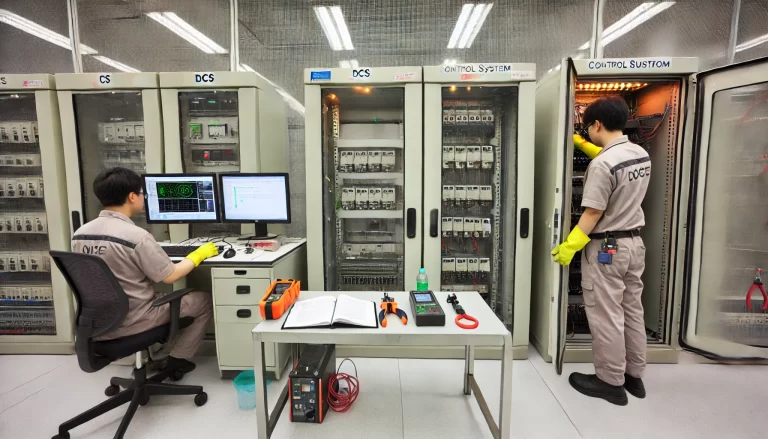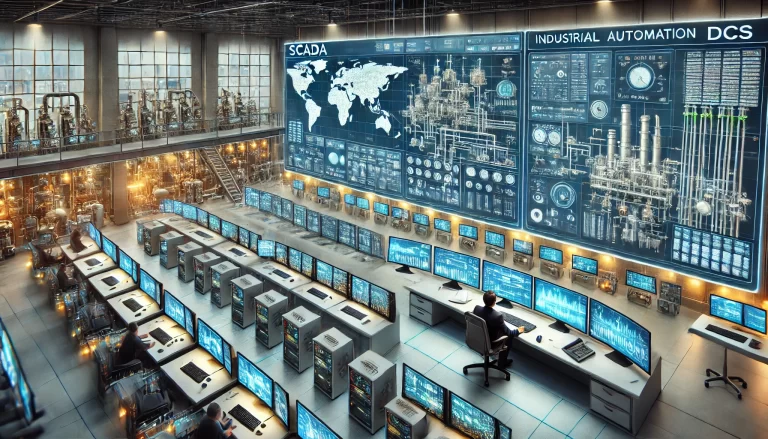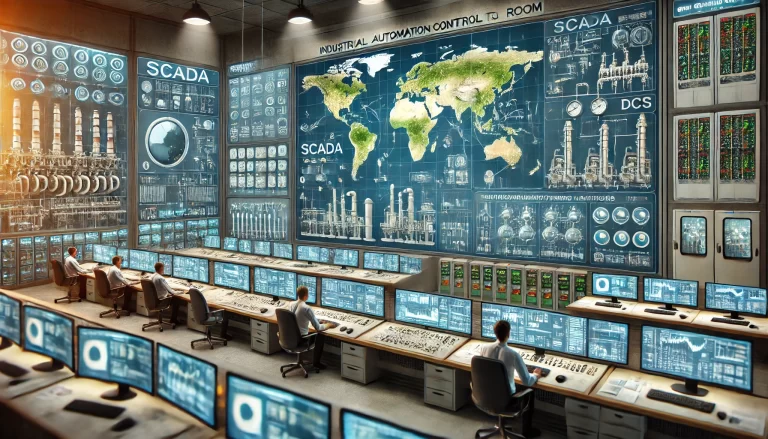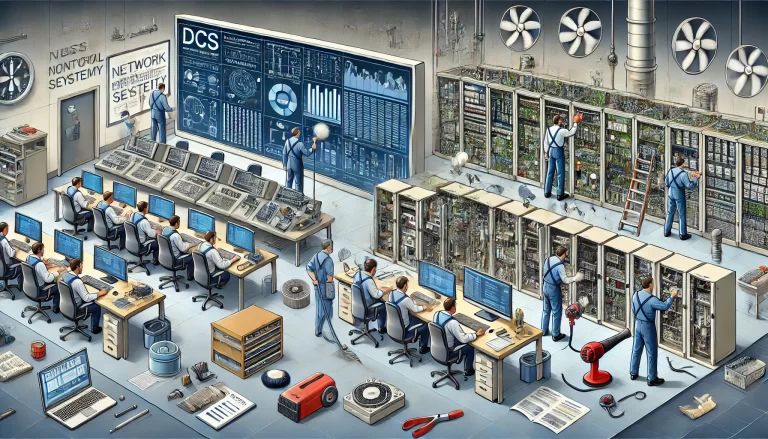Introduction
A Distributed Control System (DCS) is a critical component in modern industrial automation, especially in heavy industries such as petrochemicals, power generation, steel production, and paper manufacturing. It plays a crucial role in automating control and monitoring of complex production processes, improving efficiency, and ensuring production stability. Despite the many advantages of DCS in terms of automation and efficiency, faults can occur during its operation. This article will introduce common DCS failures, their diagnosis methods, troubleshooting techniques, and preventive measures to help engineers quickly identify and resolve issues.

Common Fault Types in DCS Systems
Hardware Failures
- Controller Failures: As the core component of a DCS, a controller failure can directly impact the system’s operation. Controller faults may be due to power supply issues, communication failures, or hardware damage.
- I/O Module Failures: The Input/Output (I/O) modules are vital for signal communication in the system. Faults may lead to sensor signal loss or errors, which can affect the entire control process.
- Network Communication Failures: Since DCS relies heavily on network communications between its various components, network failures can disrupt data exchange, causing delays or loss of control signals.
Software Failures
- Program Errors: Errors in the system’s programming can cause logical control failures, preventing the production process from running smoothly.
- Configuration Errors: Incorrect system configurations, such as improper I/O settings or incorrect parameter setups, can also lead to system malfunctions.
- Database Failures: The database within the DCS stores critical control information. Database faults may result in data loss, display errors, or system crashes.
External Factors Leading to Failures
- Environmental Factors: Temperature, humidity, electromagnetic interference, and other environmental factors can adversely affect DCS components, especially under extreme conditions.
- Power Supply Fluctuations: Voltage instability or power interruptions may cause the system to shut down or operate erratically.

DCS Fault Diagnosis Skills
Fault Phenomenon Analysis
The first step in fault diagnosis is analyzing on-site phenomena to identify the type of failure. For instance, if the system becomes unresponsive, one must determine whether the issue stems from the controller, communication faults, or I/O module failures. Common symptoms include:- Blank display screens
- Frequent or no alarms
- Unresponsiveness to inputs
On-site Testing
Hardware-related issues can be diagnosed by checking the system components on-site. Use tools like multimeters, oscilloscopes, and communication interface testers to verify power supply voltage, signal outputs, and network connections. If discrepancies are found in power or interfaces, check cable connections and port statuses.System Log Analysis
DCS systems usually log operational data automatically. By examining logs, engineers can gain valuable insights into program errors, configuration issues, or communication interruptions. Key information to look for includes:- Error codes
- Alarm signals
- System status reports
Module Replacement Method
In cases where the source of the fault remains unclear, a practical approach is to replace the suspected faulty module with a known working one. If the system returns to normal after the replacement, it indicates the failed component.Communication Link Testing
For network-related faults, engineers should use network diagnostic tools to check the status of communication links. By testing connection integrity and measuring communication delays, one can pinpoint faults in the communication infrastructure.

DCS Fault Troubleshooting Skills
Hardware Fault Resolution
- Controller Fault: If a controller fails, first check the power supply to ensure it is functioning correctly and the communication interfaces are secure. If the issue persists, the controller may need to be replaced.
- I/O Module Fault: Check the input/output voltages and currents. If a fault is detected, inspect the wiring, connectors, and terminal blocks. Replace the defective I/O module if necessary.
- Power Supply Issues: Measure the power supply voltage to ensure it is within the acceptable range. If there are fluctuations or power outages, consider repairing the power system.
Software Fault Resolution
- Program Debugging: In the event of program logic failures, engineers should debug the program and trace its execution. Reviewing the program code for errors and correcting them can resolve issues. If necessary, restore the system to the most recent backup version.
- Configuration Correction: Check the system configuration files, such as I/O setups and parameter configurations. Compare the settings with the official system manuals to ensure they are correct. Any misconfigurations should be corrected immediately.
- Database Recovery: If the system’s database is compromised, use recovery tools to restore the database to its most recent backup to maintain data integrity.
External Factors Fault Handling
- Environmental Factors: Regularly inspect the environment in which the DCS components are operating. Ensure that the temperature, humidity, and electromagnetic interference levels are within the recommended ranges. Implement shielding and environmental controls to protect the equipment.
- Power Fluctuation Mitigation: Install surge protectors or Uninterruptible Power Supply (UPS) systems to mitigate the effects of power fluctuations and ensure the DCS operates without interruption.
Network Fault Resolution
Use network diagnostic tools to analyze the network topology, communication paths, and link status. Identify faulty devices and replace them as necessary. To improve network reliability, consider enhancing the network design with redundancy or additional communication paths.

Preventive Measures and Maintenance
Regular Inspections and Maintenance
Perform regular, comprehensive checks of the DCS system, including hardware, software, and communication lines. Regularly back up system programs and databases to ensure quick recovery in case of failure.Environmental Optimization
Create an optimal working environment for DCS devices by controlling temperature, humidity, and electromagnetic interference. Minimizing these factors helps prevent equipment failures.Training and Operational Guidelines
Regularly train operators to improve their fault diagnosis and troubleshooting abilities. Develop detailed operating procedures and emergency plans to quickly address unforeseen faults.

Conclusion
The DCS is an indispensable part of modern industrial automation, widely used across various industries. Mastering fault diagnosis and troubleshooting skills is crucial for ensuring the stable operation of the system and improving production efficiency. By implementing regular maintenance and improving diagnostic techniques, engineers can effectively reduce the occurrence of DCS faults and ensure the safety and stability of production. In a complex and ever-changing industrial control environment, experienced operators and engineers are key to maintaining the long-term efficiency of DCS systems.
